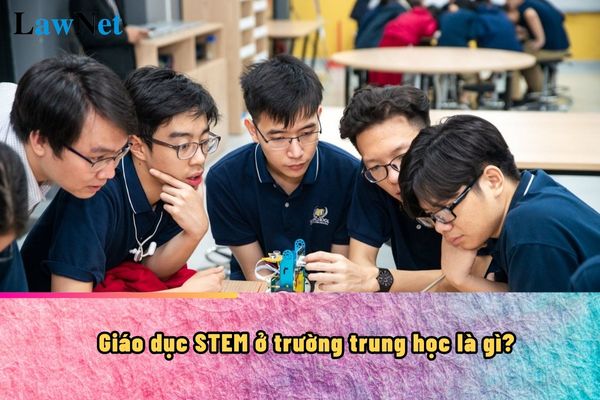What is STEM education in secondary schools in Vietnam?
What is STEM education in secondary schools in Vietnam?
According to Section 2 Official Dispatch 3089/BGDDT-GDTrH in 2020 on STEM education in lower secondary schools:
II. Forms of STEM education organization
STEM education is a teaching method aimed at equipping students with scientific knowledge linked to their practical applications.
The lesson content themed (hereinafter referred to as lesson) STEM revolves around solving a relatively complete problem, where students actively, proactively participate in learning and know how to apply newly learned knowledge to solve the problem. Through this, it helps form qualities and competencies for students.
...
Thus, STEM education in secondary school specifically is understood as a method of teaching aimed at equipping students with scientific knowledge linked to their practical applications.

What is STEM education in secondary schools in Vietnam? (Image from the Internet)
What are forms of STEM education in secondary schools in Vietnam?
According to Section 2 of Official Dispatch 3089/BGDDT-GDTrH in 2020 on STEM education in lower secondary schools, depending on the specific characteristics of each subject and the facilities available, schools can flexibly apply the following forms of STEM education organization:
Form 1. Teaching science subjects through STEM lessons
- This is the main form of STEM education organization in secondary schools. Teachers design STEM lessons to deploy during the teaching of subjects within the general education program using an intra-disciplinary or interdisciplinary integration approach.
- The content of STEM lessons aligns closely with the subject program content to implement the general education curriculum within the prescribed hours of the subject in the program.
- Students conduct STEM lessons, actively researching textbooks and learning materials to receive and apply knowledge through activities: selecting solutions to solve problems; practicing design, manufacturing, and testing models; sharing, discussing, improving or adjusting models under the teacher's guidance.
Form 2. Organizing STEM experiential activities
- STEM experiential activities are organized through club activities or practical experience activities; undertaken voluntarily according to students' interests, talents, and choices. Schools can organize STEM experiential spaces within the school; introduce digital libraries, virtual experiments, simulations, learning software for students to explore and experiment with scientific and technological applications in real life.
- STEM experiential activities are organized according to the school's annual education plan; each session's content is designed into a specific lesson, clearly describing the objectives, requirements, experience process, and expected outcomes. Priority is given to related activities, continuous activities at the application level (design, testing, discussion, and revision) of the activities in STEM lessons according to the school's teaching plan.
- Strengthen cooperation between secondary schools and higher education institutions, research facilities, vocational education institutions, enterprises, business households, other socio-economic entities, and families to effectively organize STEM experiential activities in accordance with current regulations.
Form 3. Organizing scientific and technical research activities
- This activity is for students who have the capability, interest, and enthusiasm for exploring and discovering science and technology to solve real-world problems; through organizing STEM lessons and STEM experiential activities identify talented students for nurturing, thereby creating favorable conditions for students to participate in scientific and technical research.
- Scientific and technical research activities are conducted as a research project by an individual or a group of two members, under the guidance of a teacher or a suitably specialized scientist.
- Depending on the practical situation, periodically organize STEM festivals or scientific and technical competitions at the unit to evaluate and commend the efforts of teachers and students in organizing teaching and learning, as well as select research projects to participate in higher-level scientific and technical competitions.
What are requirements for STEM experiential activities in secondary school meet?
According to sub-section 2 of Section 3 Official Dispatch 3089/BGDDT-GDTrH in 2020, STEM experiential activities in secondary school must meet the following requirements:
* The content of STEM experiential activities selected must be linked with the implementation of the goals of the general education program, creating interest and motivation for learning to develop students' qualities and competencies.
- Focus on related activities, continuous application level activities (design, testing, discussion, and revision) of the STEM lesson activities in the program, concentrating on resolving real-world social, scientific, and technological issues.
- The content of STEM experiential activities can be related to career activities in the STEM fields to support the learning process, create interest and motivation for learning, contributing to career orientation for students.
* The form of organizing STEM experiential activities needs to be rich, diverse, engaging students in exploring and applying knowledge to solve issues in real-world society, science, and technology.
- The form of organizing STEM experiential activities can be flexible, combining activities within the school (in the form of clubs) and outside the school (exploration of real-world experiences).
- Strengthen group activities to develop communication and cooperation skills for students, but ensure to specify the tasks and specific products of each student in the group.

